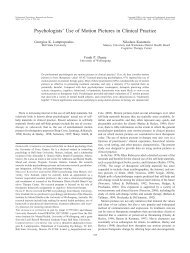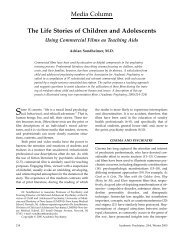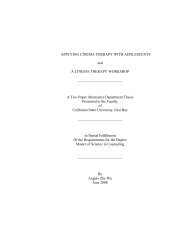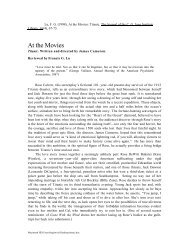Content Analysis of Romantic Comedies IN PRESS ...
Content Analysis of Romantic Comedies IN PRESS ...
Content Analysis of Romantic Comedies IN PRESS ...
Create successful ePaper yourself
Turn your PDF publications into a flip-book with our unique Google optimized e-Paper software.
<strong>Content</strong> <strong>Analysis</strong> <strong>of</strong> <strong>Romantic</strong> <strong>Comedies</strong> 16approval. As adolescence is a time where approval by others increases in importance, themajority <strong>of</strong> depictions <strong>of</strong> family and friends approving <strong>of</strong> partners may serve to reinforce theimportance <strong>of</strong> viewers’ own family and friends’ opinions <strong>of</strong> their own partners.“Sex” and “Post-Sex Behaviour” were combined to create the broader category“Sexual Activity”. After sex, couples either cuddled and talked (such as in Keeping TheFaith), connected emotionally (as in Something’s Gotta Give, where both characters cry) orone individual woke up before the other and left (as in Maid In Manhattan). However, withonly very few incidents coded pertaining to post-sex behaviour, viewers may be left stillunsure as to what is appropriate in such circumstances.“Fate/Soul Mate” and “Special Relationship” were combined to create “One-<strong>of</strong>-a-Kind Relationship”. While there were 17 coded references to either fate or to finding one’s“soul mate”, (almost half <strong>of</strong> which were coded in a single film, Serendipity), the majority <strong>of</strong>this axial category consisted <strong>of</strong> characters’ claims and/or behaviours that suggested there wassomething special or different about their relationship. For example, in How To Lose A GuyIn Ten Days, a male character brings his partner home to meet his family, at which point it isrevealed he has never done this with a partner before, and later his partner writes in themagazine she works for that the last ten days with her partner were the best in her life.“Trust in Partner”, consisting <strong>of</strong> “Trust” and “Confiding/Opening Up” was one <strong>of</strong>the smallest categories, comprising only 0.7% <strong>of</strong> the total incidents coded. Characters wereshown to open up to their partners about personal memories, insecurities, and feelings.Although partners were shown to listen and <strong>of</strong>fer emotional support if needed in return, thefar greater number <strong>of</strong> incidents <strong>of</strong> deception coded may still give adolescent viewers thefeeling <strong>of</strong> a need to demonstrate caution in relationships.The two final categories to be created at this stage were “Time Together”,(consisting <strong>of</strong> open coding categories “Dates”, “Being Playful Together”, “CelebratingAnniversary”, and “Spending Time Together”) and “Gestures” (consisting <strong>of</strong> “Chivalry”,










